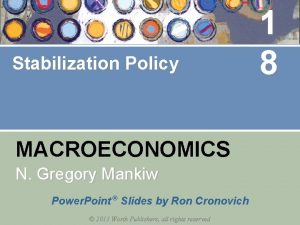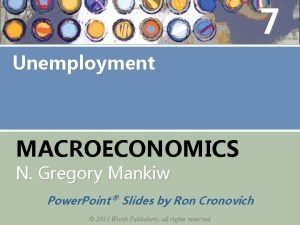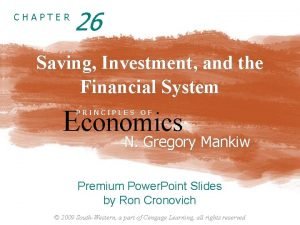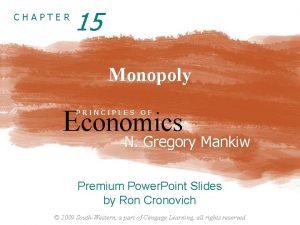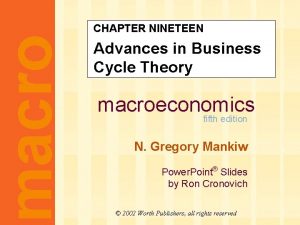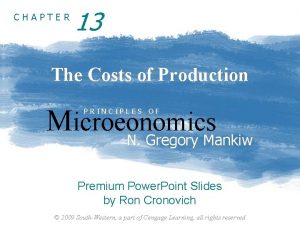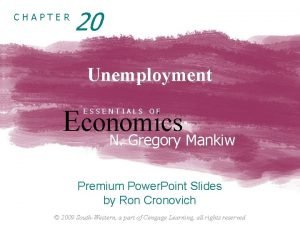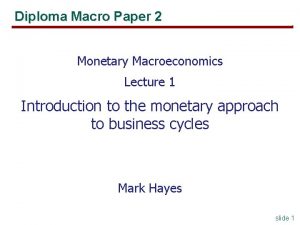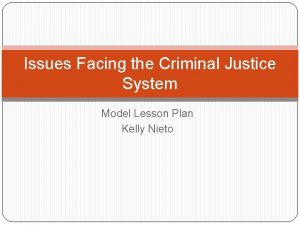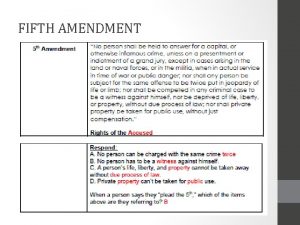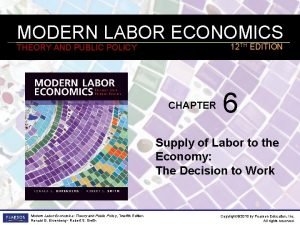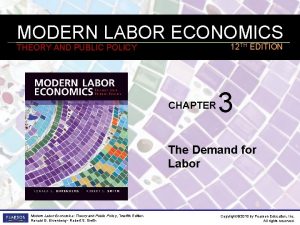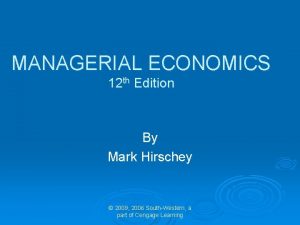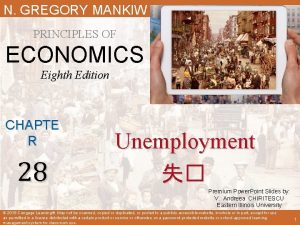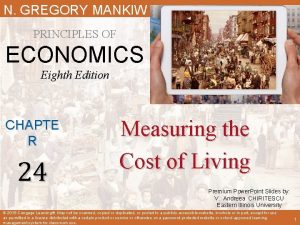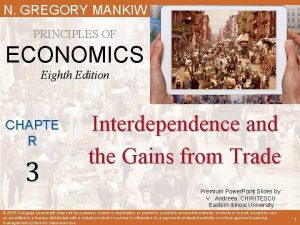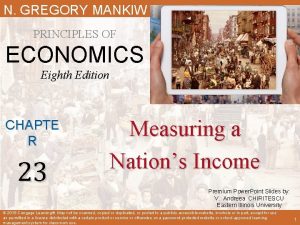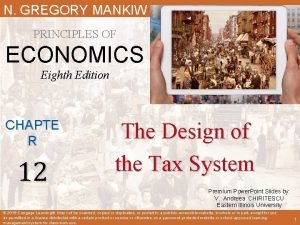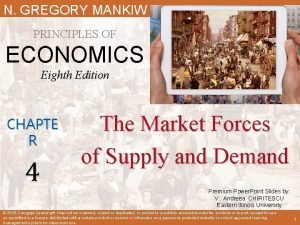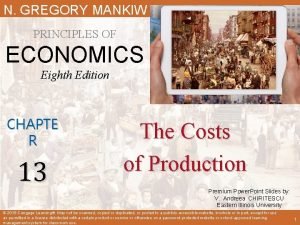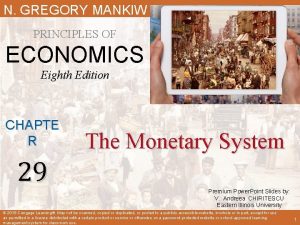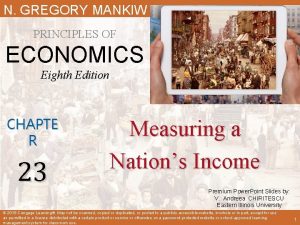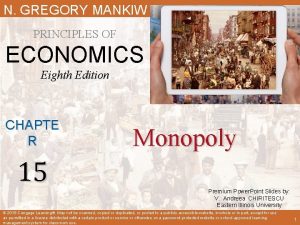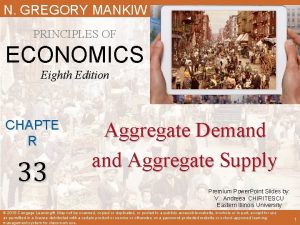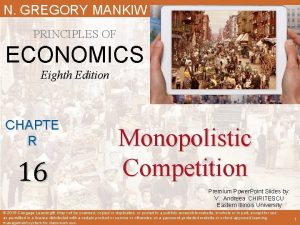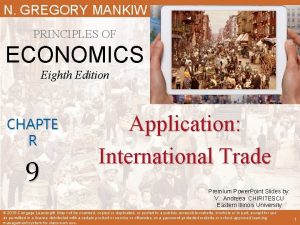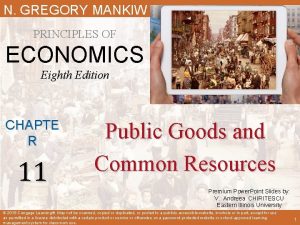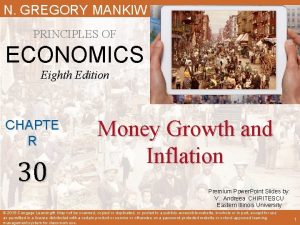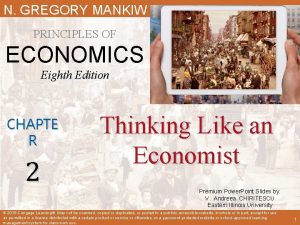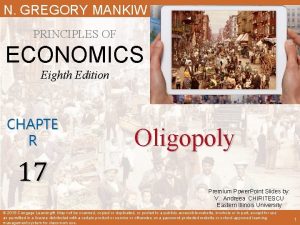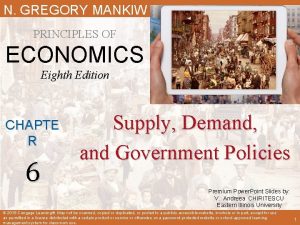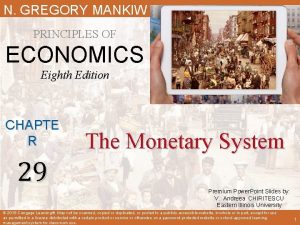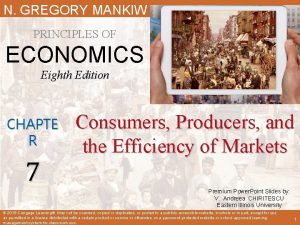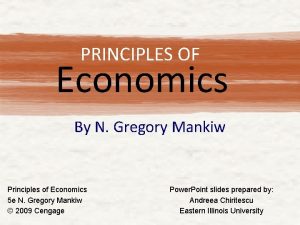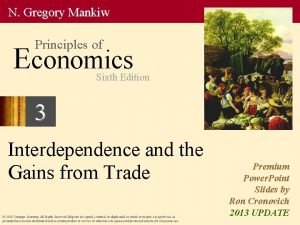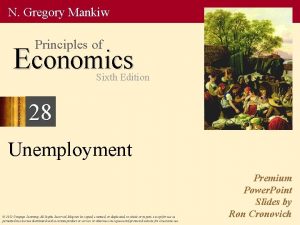N GREGORY MANKIW PRINCIPLES OF ECONOMICS Eighth Edition
































- Slides: 32

N. GREGORY MANKIW PRINCIPLES OF ECONOMICS Eighth Edition CHAPTE R 1 Ten Principles of Economics Premium Power. Point Slides by: V. Andreea CHIRITESCU Eastern Illinois University © 2018 Cengage Learning®. May not be scanned, copied or duplicated, or posted to a publicly accessible website, in whole or in part, except for use as permitted in a license distributed with a certain product or service or otherwise on a password-protected website or school-approved learning management system for classroom use. 1

Look for the answers to these questions: • What kinds of questions does economics address? • What are the principles of how people make decisions? • What are the principles of how people interact? • What are the principles of how the economy as a whole works? © 2018 Cengage Learning®. May not be scanned, copied or duplicated, or posted to a publicly accessible website, in whole or in part, except for use as permitted in a license distributed with a certain product or service or otherwise on a password-protected website or school-approved learning management system for classroom use. 2

Ten Principles of Economics • Resources are scarce • Scarcity: the limited nature of society’s resources – Society has limited resources • Cannot produce all the goods and services people wish to have • Economics – The study of how society manages its scarce resources © 2018 Cengage Learning®. May not be scanned, copied or duplicated, or posted to a publicly accessible website, in whole or in part, except for use as permitted in a license distributed with a certain product or service or otherwise on a password-protected website or school-approved learning management system for classroom use. 3

Ten Principles of Economics • Economists study: – How people decide what to buy, how much to work, save, and spend – How firms decide how much to produce, how many workers to hire – How society decides how to divide its resources between national defense, consumer goods, protecting the environment, and other needs © 2018 Cengage Learning®. May not be scanned, copied or duplicated, or posted to a publicly accessible website, in whole or in part, except for use as permitted in a license distributed with a certain product or service or otherwise on a password-protected website or school-approved learning management system for classroom use. 4

How People Make Decisions Principle 1: People face trade-offs Principle 2: The cost of something is what you give up to get it Principle 3: Rational people think at the margin Principle 4: People respond to incentives © 2018 Cengage Learning®. May not be scanned, copied or duplicated, or posted to a publicly accessible website, in whole or in part, except for use as permitted in a license distributed with a certain product or service or otherwise on a password-protected website or school-approved learning management system for classroom use. 5

Principle 1: People Face Trade-offs • To get something that we like, we have to give up something else that we also like – Going to a party the night before an exam • Less time for studying – Having more money to buy stuff • Working longer hours, less time for leisure – Protecting the environment • Resources could be used to produce consumer goods © 2018 Cengage Learning®. May not be scanned, copied or duplicated, or posted to a publicly accessible website, in whole or in part, except for use as permitted in a license distributed with a certain product or service or otherwise on a password-protected website or school-approved learning management system for classroom use. 6

Principle 1: People Face Trade-offs • Society faces trade-offs: – The more it spends on national defense (guns) to protect its shores • The less it can spend on consumer goods (butter) to raise the standard of living at home – Pollution regulations: cleaner environment and improved health • But at the cost of reducing the incomes of the firms’ owners, workers, and customers © 2018 Cengage Learning®. May not be scanned, copied or duplicated, or posted to a publicly accessible website, in whole or in part, except for use as permitted in a license distributed with a certain product or service or otherwise on a password-protected website or school-approved learning management system for classroom use. 7

Principle 1: People Face Trade-offs • Efficiency: society gets the most from its scarce resources • Equality: prosperity is distributed uniformly among society’s members • Tradeoff: – To achieve greater equality, could redistribute income from wealthy to poor – But this reduces incentive to work and produce, shrinks the size of economic “pie” © 2018 Cengage Learning®. May not be scanned, copied or duplicated, or posted to a publicly accessible website, in whole or in part, except for use as permitted in a license distributed with a certain product or service or otherwise on a password-protected website or school-approved learning management system for classroom use. 8

Principle 2: The Cost of Something Is What You Give Up to Get It • Making decisions: – Compare costs with benefits of alternatives – Need to include opportunity costs • Opportunity cost – Whatever must be given up to obtain some item © 2018 Cengage Learning®. May not be scanned, copied or duplicated, or posted to a publicly accessible website, in whole or in part, except for use as permitted in a license distributed with a certain product or service or otherwise on a password-protected website or school-approved learning management system for classroom use. 9

Principle 2: The Cost of Something Is What You Give Up to Get It • The opportunity cost of: – Going to college for a year • Tuition, books, and fees • PLUS foregone wages – Going to the movies • The price of the movie ticket • PLUS the value of the time you spend in theater © 2018 Cengage Learning®. May not be scanned, copied or duplicated, or posted to a publicly accessible website, in whole or in part, except for use as permitted in a license distributed with a certain product or service or otherwise on a password-protected website or school-approved learning management system for classroom use. 10

Principle 3: Rational People Think at the Margin • Rational people – Systematically and purposefully do the best they can to achieve their objectives – Given the available opportunities – Make decisions by evaluating costs and benefits of marginal changes • Small incremental adjustments to a plan of action © 2018 Cengage Learning®. May not be scanned, copied or duplicated, or posted to a publicly accessible website, in whole or in part, except for use as permitted in a license distributed with a certain product or service or otherwise on a password-protected website or school-approved learning management system for classroom use. 11

Principle 3: Rational People Think at the Margin • Examples: – Cell phone users with unlimited minutes (the minutes are free at the margin) • Are often prone to making long/frivolous calls • Marginal benefit of the call > 0 – A manager considers whether to increase output • Compares the cost of the needed labor and materials to the extra revenue © 2018 Cengage Learning®. May not be scanned, copied or duplicated, or posted to a publicly accessible website, in whole or in part, except for use as permitted in a license distributed with a certain product or service or otherwise on a password-protected website or school-approved learning management system for classroom use. 12

Principle 4: People Respond to Incentives • Incentive – Something that induces a person to act • Examples: – When gas prices rise, consumers buy more hybrid cars and fewer gas guzzling SUVs – When cigarette taxes increase, teen smoking falls © 2018 Cengage Learning®. May not be scanned, copied or duplicated, or posted to a publicly accessible website, in whole or in part, except for use as permitted in a license distributed with a certain product or service or otherwise on a password-protected website or school-approved learning management system for classroom use. 13

Active Learning 1 Applying the principles You are selling your 2007 Mustang. You have already spent $1, 000 on repairs. At the last minute, the transmission dies. You can pay $900 to have it repaired, or sell the car “as is. ” In each of the following scenarios, should you have the transmission repaired? Explain. A. Blue book value (what you could get for the car) is $7, 500 if transmission works, $6, 200 if it doesn’t. B. Blue book value is $6, 300 if transmission works, $5, 500 if it doesn’t. © 2018 Cengage Learning®. May not be scanned, copied or duplicated, or posted to a publicly accessible website, in whole or in part, except for use as permitted in a license distributed with a certain product or service or otherwise on a password-protected website or school-approved learning management system for classroom use. 14

Active Learning 1 Answers Cost of fixing the transmission = $900 A. Blue book value is $7, 500 if transmission works, $6, 200 if it doesn’t – Benefit of fixing transmission = $1, 300 (= 7500 – 6200) – Get the transmission fixed B. Blue book value is $6, 300 if transmission works, $5, 500 if it doesn’t – Benefit of fixing the transmission = $800 (= 6300 – 5500) – Do not pay $900 to fix it © 2018 Cengage Learning®. May not be scanned, copied or duplicated, or posted to a publicly accessible website, in whole or in part, except for use as permitted in a license distributed with a certain product or service or otherwise on a password-protected website or school-approved learning management system for classroom use. 15

How People Interact Principle 5: Trade can make everyone better off Principle 6: Markets are usually a good way to organize economic activity Principle 7: Governments can sometimes improve market outcomes © 2018 Cengage Learning®. May not be scanned, copied or duplicated, or posted to a publicly accessible website, in whole or in part, except for use as permitted in a license distributed with a certain product or service or otherwise on a password-protected website or school-approved learning management system for classroom use. 16

Principle 5: Trade Can Make Everyone Better Off • People benefit from trade: – People can buy a greater variety of goods and services at lower cost • Countries benefit from trade and specialization – Get a better price abroad for goods they produce – Buy other goods more cheaply from abroad than could be produced at home © 2018 Cengage Learning®. May not be scanned, copied or duplicated, or posted to a publicly accessible website, in whole or in part, except for use as permitted in a license distributed with a certain product or service or otherwise on a password-protected website or school-approved learning management system for classroom use. 17

Principle 6: Markets Are Usually a Good Way to Organize Economic Activity • Market – A group of buyers and sellers (need not be in a single location) • “Organize economic activity” means determining – What goods and services to produce – How much of each to produce – Who produced and consumed these © 2018 Cengage Learning®. May not be scanned, copied or duplicated, or posted to a publicly accessible website, in whole or in part, except for use as permitted in a license distributed with a certain product or service or otherwise on a password-protected website or school-approved learning management system for classroom use. 18

Principle 6: Markets Are Usually a Good Way to Organize Economic Activity • A market economy allocates resources – Decentralized decisions of many firms and households – as they interact in markets • Famous insight by Adam Smith in The Wealth of Nations (1776): – Each of these households and firms acts as if “led by an invisible hand” to promote general economic well-being © 2018 Cengage Learning®. May not be scanned, copied or duplicated, or posted to a publicly accessible website, in whole or in part, except for use as permitted in a license distributed with a certain product or service or otherwise on a password-protected website or school-approved learning management system for classroom use. 19

Principle 6: Markets Are Usually a Good Way to Organize Economic Activity • Prices: – Determined: interaction of buyers and sellers – Reflect the good’s value to buyers – Reflect the cost of producing the good • Invisible hand: – Prices guide self-interested households and firms to make decisions that maximize society’s economic well-being © 2018 Cengage Learning®. May not be scanned, copied or duplicated, or posted to a publicly accessible website, in whole or in part, except for use as permitted in a license distributed with a certain product or service or otherwise on a password-protected website or school-approved learning management system for classroom use. 20

Principle 7: Governments Can Sometimes Improve Market Outcomes • Government - enforce property rights – Enforce rules and maintain institutions that are key to a market economy • People are less inclined to work, produce, invest, or purchase if large risk of their property being stolen © 2018 Cengage Learning®. May not be scanned, copied or duplicated, or posted to a publicly accessible website, in whole or in part, except for use as permitted in a license distributed with a certain product or service or otherwise on a password-protected website or school-approved learning management system for classroom use. 21

Principle 7: Governments Can Sometimes Improve Market Outcomes • Government - promote efficiency – Avoid market failures: market left on its own fails to allocate resources efficiently – Externality – source of market failure • Production or consumption of a good affects bystanders (e. g. pollution) – Market power – source of market failure • A single buyer or seller has substantial influence on market price (e. g. monopoly) © 2018 Cengage Learning®. May not be scanned, copied or duplicated, or posted to a publicly accessible website, in whole or in part, except for use as permitted in a license distributed with a certain product or service or otherwise on a password-protected website or school-approved learning management system for classroom use. 22

Principle 7: Governments Can Sometimes Improve Market Outcomes • Government - promote equality – Avoid disparities in economic wellbeing – Use tax or welfare policies to change how the economic “pie” is divided © 2018 Cengage Learning®. May not be scanned, copied or duplicated, or posted to a publicly accessible website, in whole or in part, except for use as permitted in a license distributed with a certain product or service or otherwise on a password-protected website or school-approved learning management system for classroom use. 23

Active Learning 2 Discussion Question In each of the following situations, what is the government’s role? Does the government’s intervention improve the outcome? a. b. c. d. Public schools for K-12 Workplace safety regulations Public highways Patent laws, which allow drug companies to charge high prices for life-saving drugs © 2018 Cengage Learning®. May not be scanned, copied or duplicated, or posted to a publicly accessible website, in whole or in part, except for use as permitted in a license distributed with a certain product or service or otherwise on a password-protected website or school-approved learning management system for classroom use. 24

How the economy as a whole works Principle 8: A country’s standard of living depends on its ability to produce goods and services Principle 9: Prices rise when the government prints too much money Principle 10: Society faces a short-run trade -off between inflation and unemployment © 2018 Cengage Learning®. May not be scanned, copied or duplicated, or posted to a publicly accessible website, in whole or in part, except for use as permitted in a license distributed with a certain product or service or otherwise on a password-protected website or school-approved learning management system for classroom use. 25

Principle 8: Country’s Standard of Living Depends on Its Ability to Produce Goods and Services • Huge variation in living standards – Across countries and over time – Average income in rich countries • Is more than ten times average income in poor countries – The U. S. standard of living today • Is about eight times larger than 100 years ago © 2018 Cengage Learning®. May not be scanned, copied or duplicated, or posted to a publicly accessible website, in whole or in part, except for use as permitted in a license distributed with a certain product or service or otherwise on a password-protected website or school-approved learning management system for classroom use. 26

Principle 8: Country’s Standard of Living Depends on Its Ability to Produce Goods and Services • Productivity: most important determinant of living standards – Quantity of goods and services produced from each unit of labor input – Depends on the equipment, skills, and technology available to workers • Other factors (e. g. , labor unions, competition from abroad) have far less impact on living standards © 2018 Cengage Learning®. May not be scanned, copied or duplicated, or posted to a publicly accessible website, in whole or in part, except for use as permitted in a license distributed with a certain product or service or otherwise on a password-protected website or school-approved learning management system for classroom use. 27

Principle 9: Prices Rise When the Government Prints Too Much Money • Inflation – An increase in the overall level of prices in the economy • In the long run – Inflation is almost always caused by excessive growth in the quantity of money, which causes the value of money to fall – The faster the government creates money, the greater the inflation rate © 2018 Cengage Learning®. May not be scanned, copied or duplicated, or posted to a publicly accessible website, in whole or in part, except for use as permitted in a license distributed with a certain product or service or otherwise on a password-protected website or school-approved learning management system for classroom use. 28

Principle 10: Society Faces a Short-run Tradeoff between Inflation and Unemployment • Short-run trade-off between unemployment and inflation – Over a period of a year or two, many economic policies push inflation and unemployment in opposite directions – Other factors can make this tradeoff more or less favorable, but the tradeoff is always present © 2018 Cengage Learning®. May not be scanned, copied or duplicated, or posted to a publicly accessible website, in whole or in part, except for use as permitted in a license distributed with a certain product or service or otherwise on a password-protected website or school-approved learning management system for classroom use. 29

Summary • Fundamental lessons about individual decision making: – People face trade-offs among alternative goals – The cost of any action is measured in terms of forgone opportunities – Rational people make decisions by comparing marginal costs and marginal benefits – People change their behavior in response to the incentives they face © 2018 Cengage Learning®. May not be scanned, copied or duplicated, or posted to a publicly accessible website, in whole or in part, except for use as permitted in a license distributed with a certain product or service or otherwise on a password-protected website or school-approved learning management system for classroom use. 30

Summary • Fundamental lessons about interactions among people: – Trade and interdependence can be mutually beneficial – Markets are usually a good way of coordinating economic activity among people – The government can potentially improve market outcomes by remedying a market failure or by promoting greater economic equality © 2018 Cengage Learning®. May not be scanned, copied or duplicated, or posted to a publicly accessible website, in whole or in part, except for use as permitted in a license distributed with a certain product or service or otherwise on a password-protected website or school-approved learning management system for classroom use. 31

Summary • Fundamental lessons about the economy as a whole: – Productivity is the ultimate source of living standards – Growth in the quantity of money is the ultimate source of inflation – Society faces a short-run trade-off between inflation and unemployment © 2018 Cengage Learning®. May not be scanned, copied or duplicated, or posted to a publicly accessible website, in whole or in part, except for use as permitted in a license distributed with a certain product or service or otherwise on a password-protected website or school-approved learning management system for classroom use. 32
 Principles of economics mankiw 9th edition ppt
Principles of economics mankiw 9th edition ppt Principles of economics mankiw 9th edition ppt
Principles of economics mankiw 9th edition ppt Macroeconomics mankiw 9th edition
Macroeconomics mankiw 9th edition Psychology eighth edition david g myers
Psychology eighth edition david g myers Psychology
Psychology Operations management eighth edition
Operations management eighth edition Principles of economics third edition
Principles of economics third edition Rational people think at the margin
Rational people think at the margin Mankiw chapter 26 solutions
Mankiw chapter 26 solutions Chapter 15 monopoly
Chapter 15 monopoly Macroeconomics by mankiw
Macroeconomics by mankiw The costs of production chapter 13
The costs of production chapter 13 Intermediate macroeconomics mankiw
Intermediate macroeconomics mankiw Mankiw slides
Mankiw slides Mankiw
Mankiw Anagram of eighth
Anagram of eighth Matching planet rings
Matching planet rings Nearest eighth of an inch
Nearest eighth of an inch The fifth, sixth, seventh, and eighth amendments protect *
The fifth, sixth, seventh, and eighth amendments protect * What is the eighth commandment catholic
What is the eighth commandment catholic What is the eighth wonder
What is the eighth wonder Reversed three quarter crown
Reversed three quarter crown Eighth amendment excessive bail
Eighth amendment excessive bail Eighth letter of the alphabet
Eighth letter of the alphabet Criminal justice lesson
Criminal justice lesson 8 amendment
8 amendment Using mis (10th edition) 10th edition
Using mis (10th edition) 10th edition Using mis (10th edition) 10th edition
Using mis (10th edition) 10th edition Modern labor economics 12th edition solution
Modern labor economics 12th edition solution Modern labor economics 12th edition
Modern labor economics 12th edition Macroeconomics michael parkin 13th edition
Macroeconomics michael parkin 13th edition Managerial economics hirschey
Managerial economics hirschey Parkin economics 12th edition
Parkin economics 12th edition
